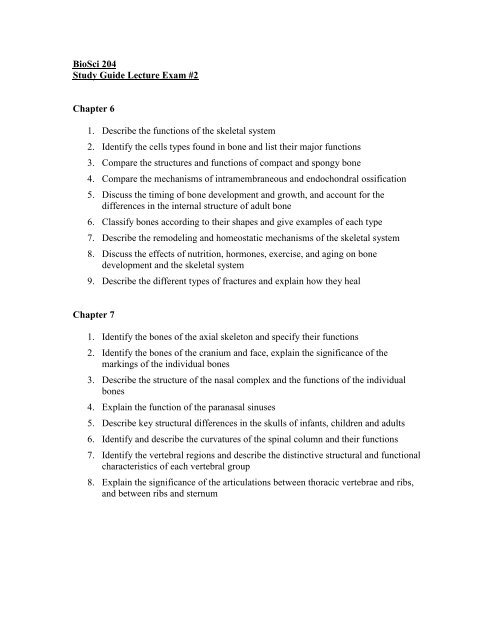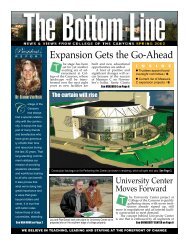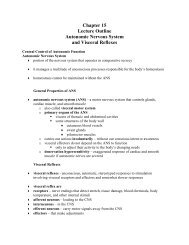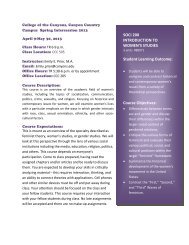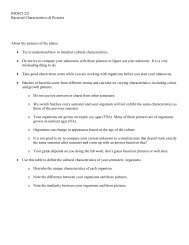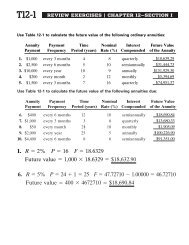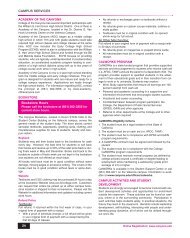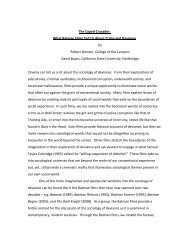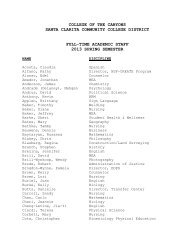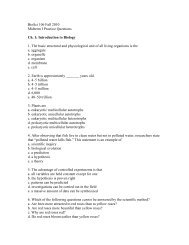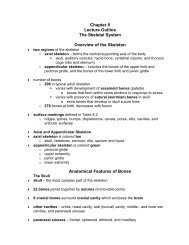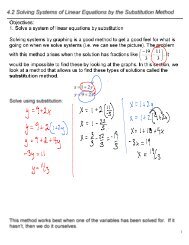Lecture Exam 2
Lecture Exam 2
Lecture Exam 2
You also want an ePaper? Increase the reach of your titles
YUMPU automatically turns print PDFs into web optimized ePapers that Google loves.
BioSci 204<br />
Study Guide <strong>Lecture</strong> <strong>Exam</strong> #2<br />
Chapter 6<br />
1. Describe the functions of the skeletal system<br />
2. Identify the cells types found in bone and list their major functions<br />
3. Compare the structures and functions of compact and spongy bone<br />
4. Compare the mechanisms of intramembraneous and endochondral ossification<br />
5. Discuss the timing of bone development and growth, and account for the<br />
differences in the internal structure of adult bone<br />
6. Classify bones according to their shapes and give examples of each type<br />
7. Describe the remodeling and homeostatic mechanisms of the skeletal system<br />
8. Discuss the effects of nutrition, hormones, exercise, and aging on bone<br />
development and the skeletal system<br />
9. Describe the different types of fractures and explain how they heal<br />
Chapter 7<br />
1. Identify the bones of the axial skeleton and specify their functions<br />
2. Identify the bones of the cranium and face, explain the significance of the<br />
markings of the individual bones<br />
3. Describe the structure of the nasal complex and the functions of the individual<br />
bones<br />
4. Explain the function of the paranasal sinuses<br />
5. Describe key structural differences in the skulls of infants, children and adults<br />
6. Identify and describe the curvatures of the spinal column and their functions<br />
7. Identify the vertebral regions and describe the distinctive structural and functional<br />
characteristics of each vertebral group<br />
8. Explain the significance of the articulations between thoracic vertebrae and ribs,<br />
and between ribs and sternum
Chapter 8<br />
1. Identify each bone of the appendicular skeleton<br />
2. Identify the bones that form the pectoral girdle, their functions, and their<br />
superficial features<br />
3. Identify the bones of the upper limb, their functions, and their superficial features<br />
4. Identify the bones that form the pelvic girdle, their functions, and their superficial<br />
features<br />
5. Identify the bones of the lower limb, their functions, and their superficial features<br />
6. Discuss structural and functional differences between the pelvis of a female and<br />
that of a male<br />
Chapter 9<br />
1. Contrast the major categories of joints and explain the relationship between<br />
structure and function for each category.<br />
2. Describe the basic structure of a synovial joint, identifying possible accessory<br />
structures and their functions<br />
3. List the different types of synovial joints and discuss how the characteristics<br />
motions of each type are related to its anatomical structure<br />
4. Explain the relationship between joint strength and mobility, using specific<br />
examples<br />
5. Describe the dynamic movements of the skeleton<br />
6. Describe the articulations between the vertebrae of the vertebral column<br />
7. Describe the structure and function of the shoulder, elbow, hip, knee, and<br />
temporomandibular joints.


